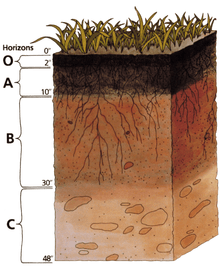Soil functions
Soil functions are general capabilities of soils that are important for various agricultural, environmental, nature protection, landscape architecture and urban applications. Six key soil functions are:,[1][2]
- Food and other biomass production
- Environmental Interaction: storage, filtering, and transformation
- Biological habitat and gene pool
- Source of raw materials
- Physical and cultural heritage
- Platform for man-made structures: buildings, highways
Mapping soil functions
Soil maps can depict soil properties and functions in the context of specific soil functions such as agricultural food production, environmental protection, and civil engineering considerations. Maps can depict functional interpretations of specific properties such as critical nutrient levels, heavy-metal levels or can depict interpretation of multiple properties such as a map of erosion risk index.
Mapping of function specific soil properties is an extension of soil survey, using maps of soil components together with auxiliary information (including pedotransfer functions and soil inference models) to depict inferences about the specific performance of soil mapping units. Other function of soil in our ecosystem:
- source of building materials (clay, sand, rocks)
- carbon recycler
- fiber production
See also
References
- ↑ Blum, WEH (1993). HJP Eijsackers and T Hamers, ed. Soil Protection Concept of the Council of Europe and Integrated Soil Research. Soil and Environment Vol 1. Kluwer Academic Publisher, Dordrecht. pp. 37–47.
- ↑ DETR (2001). (title unknown).
